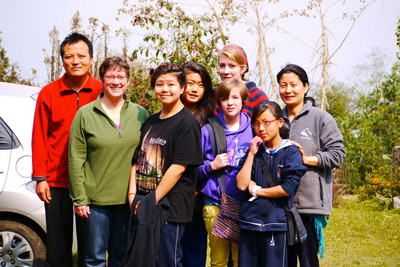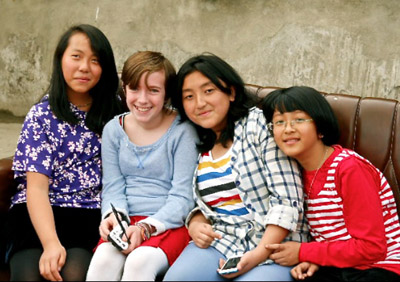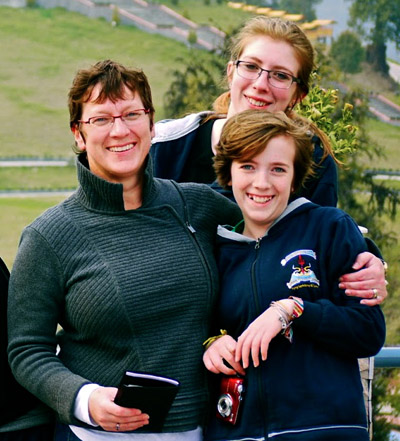'Only at Taktse'
Chris Stodolski ’89 and daughters enlarge their worldview during their Sikkim sojourn

Chris Stodolski recently volunteered to teach for a year at Taktse International School near Napal taking her daughters along for the experience. Above is Chris Stodolski with some of the Taktse school children and her daughters Corrina and Grace Berntson.
When I decided to attend Swarthmore, I thought I would become a physicist. But taking Professor Lisa Smulyan’s introduction to education course set my career path in a new direction—the field of education. Other experiences also influenced my outlook on life in unexpected ways. Through my freshman roommate (and now lifelong friend) Ipek Ilkkaracan ’89, who arrived from Turkey, a whole new world opened up to me. Meeting her and becoming involved in Swarthmore’s International Club had a big impact on my life. Through the people I met in the club, I learned that my American experience was a small piece of a large mosaic.
Despite my interest in the wider world, my travels went only as far as Europe and the western edge of Turkey, until 2012. That year, I was given the opportunity to combine the two loves I discovered at Swarthmore—understanding new places and the field of education. It’s amazing to think that I would be combining the two in a place as remote as the Himalayan mountains. But it all came together when I volunteered at Taktse International School in Gangtok in the Indian state of Sikkim, which borders Nepal.
I had always hoped that as a parent I might have the opportunity to take my children abroad for a school year. While Taktse’s principal, Pintso Lauenstein-Denjongpa, was at Harvard getting his master’s degree in education, I was working as assistant head of school nearby at Gann Academy in Waltham, Mass. Pintso and I met a few times to talk about the strategic objectives for the school and about his role as principal there. We also discussed the possibility of my coming over to Sikkim to help him in a more comprehensive way. After discussing it at length with my family, I decided I would volunteer at Taktse from August 2012 to May 2013, bringing along my daughters Grace and Corrina, who would attend the school. My husband Glenn Berntson ’89 stayed behind to hold down the fort but would come visit us during our adventure. To do this I decided I would step down from my job at Gann. It was a difficult decision to make, as I would be leaving a job and a school that I loved, but I gained a life-transforming experience in return.

Daughter Corrina Berntson and her new friends.
Glenn was thrilled about our opportunity, but my two daughters were less than enthusiastic. My daughter Grace (then 15) didn’t want to leave her friends in America; she cried for two hours on the plane to Delhi out of sadness and fear. Corinna (then 12) loved her math class and her math teacher at her previous school, The Waring School in Beverly Mass., and didn’t know how she could possibly learn math or science at a remote school in the Himalayas. I was excited and could not wait to go, but I didn’t know what to expect. I thought I would find the experience wonderful, but I was concerned that it would be too challenging for the girls and that their fears would prevent them from really gaining from all that Taktse had to offer.
As we journeyed to Taktse, I contemplated some of the most difficult questions in my life. Had I made the wrong decision? Was I pushing the girls too hard? I worried about being a single parent with two children stressed by surroundings that were so different from the comforts of home.
When we first arrived, we did struggle. There were unfamiliar names, smells, accommodations, and customs that put us on OUR guard. We tried to anticipate what might happen in a given situation, and most often our guesses missed the mark! The girls were wary, and I was exhausted. But as the weeks passed, new friendships emerged for all of us; we quickly discovered that the Taktse community was happy to help us understand how the world works in Sikkim and at Taktse. With the help of everyone we met, we created a home away from home in Gangtok and found plenty of opportunities for learning in the warm and welcoming Taktse community.
Taktse is a K-12 school that reminds me of my time at Swarthmore—a crossroad where cultures intersect and people bring their best selves to the table. Taktse was born of a desire to elevate the values of Sikkimese Buddhist traditions so that students can feel a renewed connection to their culture and history. But Taktse’s mission is to do so by fostering a Western approach to learning. The school asks children to actively engage in their own education, reflect on and question their customs and rituals, be curious about how they can learn and grow, then share their newfound knowledge, thereby renewing their community. It takes a strong community, a group of people who know who they are, to feel comfortable in the face of such questioning and reflection. This is what I loved about Swarthmore and what I reveled in while at Taktse.

Chris Stodolski with daughters Grace and Corrina.
Our nine months at Taktse transformed all of us. Grace even made such close friends that she moved to their hostel to live with them. “They are my family, too,” she said. “How am I going to leave them?” I am so proud of the way Grace allowed herself to become immersed in a place that at first seemed so foreign and hard to understand. But she took to the customs and culture as if they had been instilled at an early age. Grace also learned the art of formal essay writing in her English class and earned a B on the AS Level Cambridge Exam with the help and support of her teachers and classmates.
My other daughter, Corinna, became an orchid enthusiast while at Taktse. On a hike in a nature reserve she learned to identify the five different species of orchids. “Only at Taktse!” she said about the amazing orchid workshop she attended. Corrina was reluctant to come to Sikkim, but she learned that she could create a sense of community in a place so different from her comfortable home. She and her friends swapped favorite books, and everyone at school encouraged Corrina to continue the origami work she brought with her from the United States.
This school is unlike anything I have ever experienced, and those involved take their commitment to a level I haven’t seen before. These include board members like Paul Lauenstein ’72, the uncle of Taktse’s principal, who have devoted themselves to constructing new buildings and improving the school infrastructure, teachers who work harder than they would in any other posting, and volunteers in the United States who give impressive amounts of their time and expertise to help the school. I am counting the days until I can return to Taktse.
For more information about Taktse, please go to www.taktse.org or www.facebook.com/TaktseInternational.
 Email This Page
Email This Page